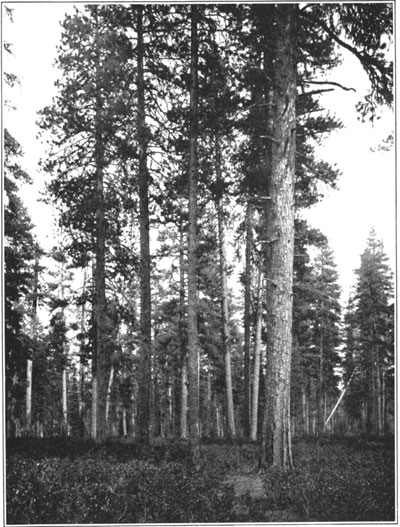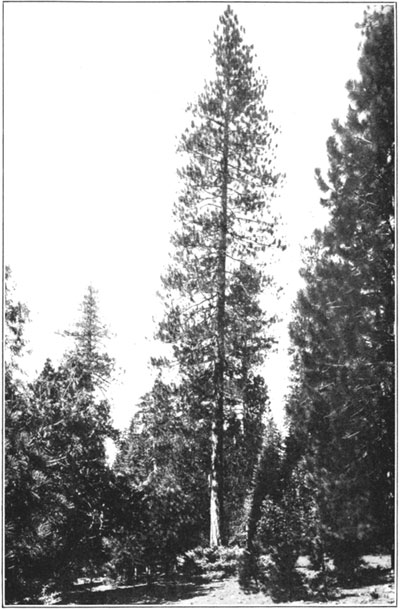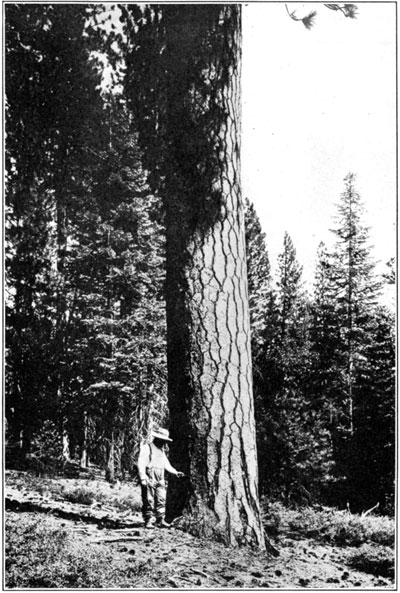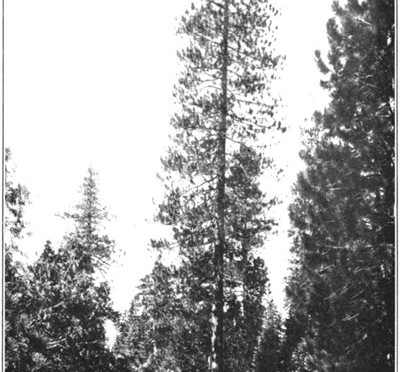Forests of Crater Lake National Park
Western Yellow Pine (Pinus Ponderosa)
In the first forests that are encountered bordering the various roads leading to Crater Lake the attention of the traveler is claimed by noble trees with cylindrical, yellowish-brown trunks and rounded or spire-shaped heads, dotted throughout brush-covered areas, or stretching in open bodies over the hills and higher slopes. This tree is western yellow pine (Pinus ponderosa), a species that is at home throughout much of the southern and eastern Oregon region (figs. 1, 2, and 3).

Fig. 1—Western yellow pine (Pinus ponderosa)
Western yellow pine in old age forms a magnificent straight, stout, round trunk, and carries its heavy limbs far out from the body, forming a cylindrical or flat-topped crown. On large trees the bark usually is not over 2 inches in thickness and is broken up into large plates by deep, narrow furrows. The surface of the bark is composed of small irregular scales, whose yellowish-brown color gives to the trunks of forest-grown trees their soft, warm tone. Younger trees have thicker, dark-brown bark that is divided into rounded ridges, and the crowns as a rule are more conical and pointed.
This species is a three-needle pine; that is, its long, flexible needles are bound in clusters of three, which are thickly disposed in tufts near the ends of the twigs. Yellow-pine cones are oval, from 3 to 5 inches in length, and usually occur in small clusters at the ends of the branches. Two years are required for their development, and during the second autumn the prickly cone scales spread widely, liberating the seeds, shortly after which they fall to the ground. The soft carpet of needles beneath old yellow pines usually is thickly studded with the rich chestnut-brown cones. As a rule yellow pine does not begin to produce seed until the trees are 40 to 50 years old, and after this age quantities of seed are produced only every two or three years.

Fig. 2—Western yellow pine (Pinus ponderosa) 70 inches in diameter
Yellow pine is one of the most widely distributed trees of North America. From the Black Hills of the Dakotas its range reaches westward nearly to the Pacific Ocean, and, braving rigors of the climate of southern British Columbia, it extends southward through the coast States and Rocky Mountain region to the hot and arid mesas of Lower California and Mexico. Usually it prefers regions where the summers are warm and dry, and it will take hold and do well on any except wet soils.
Throughout much of its range this tree is highly prized by the lumberman on account of the excellent quality of timber its straight, clear trunks produce. In eastern Oregon it is by far the most important timber tree, and this also is true throughout much of California and in many portions of the Southwest. In 1911 western yellow pine ranked sixth in the lumber production of the United States.

Fig. 3—Western yellow pine (Pinus ponderosa)
Barring accidents in the form of damage from forest fire, insect attacks, and fungous diseases, a yellow pine may reach a mature age of 400 to 500 years, attaining a diameter of 30 to 40 inches and a height of 100 to 150 feet. The average mature tree in the Fort Klamath region is about 36 inches in diameter and 120 feet in height. The age of such trees usually is between 350 and 400 years, and on average they contain about 2,500 feet board measure of merchantable timber. Tall trees, having a diameter of 4 to 5 feet, when felled and converted to lumber, may produce from 6,000 to 7,000 feet board measure, or enough to build a modern frame house of good size.
Along the Anna Creek Road yellow pine forms a considerable part of the magnificent forest up to an elevation of about 5,000 feet, but beyond this elevation it is replaced by other species that thrive better in the more moist soil and humid atmosphere of the higher country. Most of the park lies above 5,000 feet, thus excluding yellow pine, except in a narrow strip along the southern edge that ends shortly above the south entrance. Approaching the park from the west side, the traveler will see an abundance of fine yellow-pine timber from the foothills near Medford to the upper part of the Rogue River drainage.
1 This species is known as yellow pine in Glacier and Yellowstone National Parks.
Other pages in this section
*** previous title *** --- *** next title ***


